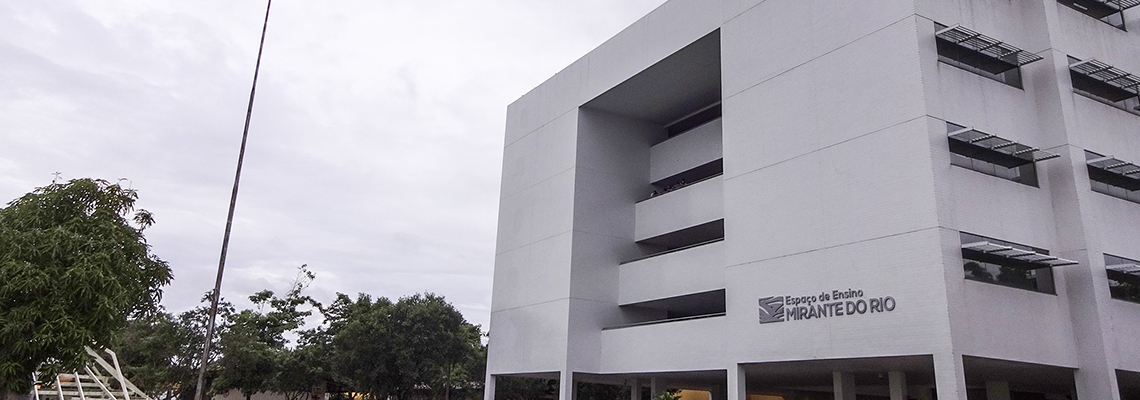Master’s/Doctorate
Concentration Area: Applied Computing
Performance Evaluation of Distributed Networks and Systems
Syllabus: Motivation to the performance evaluation of distributed computational systems: purpose, applicability, considered parameters (input data and performance measures). Taxonomy of the performance evaluation techniques: gauging and modelling. Modelling techniques: Queueing networks, Petri and Statcharts Networks. Analytical solutions: stochastic processes overview; Markovian processes (Markov Chains at Discrete and at Continuous time); Queueing Theory (definitions, notations, distribution of probabilities, M/M/1 particular cases, Jackson Networks, BCMP, hierarchical decomposition and performance limits). Solution by simulation: discrete and continuous nature; guidance for activities, events and processes; stages of a simulation; languages and tools for simulation; distributed simulation (optimistic and conservative protocols). Case-studies.
Evolutionary Computing
Syllabus: Introduction and fundamental concepts of evolutionary systems (Evolution and Natural Selection). Genetic Algorithm: concepts, modelling and application. Evolutionary Strategies: fundamentals, examples of application. Evolutionary Programming: concepts, fundamentals and application. Other Evolutionary Algorithms (Differential Evolution, cultural algorithms). Hybrid Algorithms.
Special Studies
Syllabus: Contents vary according to the topic covered.
Computational Intelligence (Mandatory)
Syllabus: nitial considerations in the area of Computational Intelligence. Symbolic computational intelligence. Connectionist computational intelligence. Evolutionary computational intelligence. Probabilistic computational intelligence. Artificial neural networks. Neuron model, Topologies of artificial neural networks. Fuzzy systems: fuzzy sets. Fuzzy rule set. Genetic algorithms. Bayesian Networks. Applications of computational intelligence.
Data Mining
Syllabus: Initial considerations of the data mining area, objectives, characteristics and applications. Data analysis and preprocessing. Data mining tasks: sorting, grouping, association, and prediction. Main techniques: decision tree and rules, rules of associations, neural networks, Bayesian networks and clustering etc. Contents: Initial considerations; Process of knowledge discovery in database; Pre-processing of data; Basic concepts of data mining; Main tasks of data mining; Basic principles and applications of the main data mining algorithms: decision tres and rules, association rules, neural networks, Bayesian networks and clustering etc .; Analysis and interpretation of results; Preparation and presentation of projects.
System Optimization
Syllabus: Fundamentals of optimization. Functions, objective and constraints. Linear programming: simplex algorithm and its variations, transport algorithms, resource allocation and decomposition methods. Unrestricted nonlinear programming: linearization, feasible directions. Gradient method. Newton's method. Quasi-Newton Methods. Penalties method. Restricted nonlinear programming: Lagrange multipliers, Kuhn-Tucker optimality. Multiobjective programming. Search methods. Integer programming: linear and non-linear.
Stochastic Processes (Mandatory)
Syllabus: Theory of Probability and Random Variables. Sequence of Random Variables. Types of Convergence. Law of the Great Numbers. Stochastic Processes. Stationary. Autocorrelation. Cross-correlation. Spectral Density. Gaussian processes. Poisson and Markov processes. Linear Systems with Random Inputs. Filtration. Prediction and Estimation.
Virtual Reality
Syllabus: Definition and Characterization of Virtual Reality: Virtual Reality Systems, Virtual Reality Overview, Virtual Reality Devices, Virtual Reality Creation Tools, Virtual Reality Applications. Principles of Computer Graphics for Virtual Reality: 3D Graphic Programming, Geometric Modeling, Geometric Transformations, Projection Transformations, Interaction and Animation, Lighting and Texture.
Computer Networks (Mandatory)
Syllabus: TCP / IP and OSI architecture, Application layer, Transport layer, Network layer, Link layer, Physical layer, Simulation of protocols and computer networks, Multimedia network applications. New technologies in computer networks. Trends and Challenges for Computer Networks.
Neural Networks
Syllabus: Introduction to Artificial Neural Networks. Representation and acquisition of knowledge: the study of knowledge in neural networks, learning in neural networks, learning strategies, learning tasks and learning rules. Connectionist paradigms (models): Perceptron, Adaline, Multi-layer Perceptron, Radial Base Networks and Kohonen's Self-Organizing Maps. Implementation and Applications of Neural Networks.
Optical Networks
Syllabus: Technology of optical systems: optical fibers; optic components and modulation and demodulation in optical systems. Optical networks: first-generation optical networks; selection and distribution networks; networks with wavelength routing; virtual topology of optical networks; control and management of optical networks; access networks and packet-switched photonic networks. Case Study.
Access Network Technologies
Syllabus: Introduction to access networks. Wired access networks: xDSL networks. PLC networks. Fiber optic access networks. Coaxial cable. Hybrid networks with fiber optic (FFTx, HFC). Wireless Access Networks: Wireless LAN. Mobile cellular system (UMTS / LTE). Satellite access networks. Hybrid fiber-radio networks (RoF), fiber-wireless (FiWi).
Special Topics in Applied Computing
Syllabus: Contents vary according to the topic covered.
Special Topics in Applied Computing: 5G Networks
Syllabus: General concepts; current and future challenges of wireless communications; Mechanisms and effects of propagation; Empirical and statistical models of the wireless channel; New technologies of wireless communications – Cellular 5G; and Planning techniques for mobile and nomadic wireless networks.
Concentration Area: Electric Energy Systens
Analysis of Electric Power Systems (Mandatory)
Syllabus: Defect Analysis in Power Systems. Short Circuits and Monopolar and Bipolar Openings. Digital Calculation of Power Flow. Techniques of Sparsity. Main Methods of Power Flow Solution. Computational Applications.
Digital Control of Systems (Mandatory)
Syllabus: Temporal response characteristics. Stability of discrete systems. Design of digital controllers in the z domain. Digital controllers based on analog controllers. RST controllers. Systems with deterministic and stochastic perturbations. Minimum variance controllers. Self-adjusting adaptive control. Discrete systems in state space. Design of digital controllers in state space using the LQR method. State estimator / fuser design by Kalman filter. LQG controller.
Robust Control of Multivariate Systems
Syllabus: Standards for Signals and Systems. Basic concepts. Uncertainty and Robustness. Stabilization. Project Restrictions. Obtainment of appropriate frequency response curves (loopshaping). Advanced Loopshaping. Matching of Models. Design for performance. Optimization of the stability margin. Project for Robust Performance.
Atmospheric Discharges
Syllabus: The scope of this discipline is to give the student a physical understanding of the phenomena associated with the electric discharges in the terrestrial atmosphere. The detection and location of these discharges by means of electromagnetic systems in several operating frequency bands. The protection of living beings, buildings, electrical systems and communications.
Dynamics and Control of Power Systems
Syllabus: Structure and characteristics of power systems. Basic aspects of dynamics and control. Theory and modeling of the synchronous machine. Park’s transformation. Flow and current models. Equations of stress. Models in the state space. Representation P.U. Equivalent circuits. Inductances and time constants in a permanent, transient and subtransient regime. Characteristics of performance in transient and permanent regime. Magnetic saturation. Linear model. Block diagrams. Representation in the space of states. Characteristic excitation systems. Types of excitation systems. Performance characteristics. Modeling of excitation systems. Basic concepts of charges modeling. Models of Induction Motors. Synchronous Motors Models. Primary machines. Power supply systems: hydraulic turbines and regulatory systems. Steam turbines and regulating systems. Control of active power and frequency. Control of reactive power and voltage.
Energy Efficiency (Mandatory)
Syllabus: Introduction: Why consume energy efficiently? World Energy Outlook. Brazilian energy panorama: current state and perspectives. Energy and development. Energy and environment. 2. Final energy consumption: lighting, driving force. Electric distribution circuits. 3. Foundations of economic analysis for energy efficiency programs. Measurement and Verification. Return on investments. Cash flow. 4. Demand-side management. What is GLD? Integrated resource planning and demand-side management. Case study in Brazil and abroad. 5. Energy efficiency programs: technological options. Energy efficiency initiatives. Marketing of energy efficiency. Forecast of impact of energy efficiency programs. Tariffs, costs of energy efficiency programs. 6.Efficient energy consumption in buildings. RTQ. Control and demand management. Energy efficiency indices. 7.Legislation: Standards. Public policy. PROCEL and its achievements. Experiences abroad.
High Voltage and Techniques (Mandatory)
Syllabus: 1.Introduction. 2.Equipment of maneuver. 2.1. Sectional switches. 2.2. Religadores. 2.3 Power switches. 3. Converting equipment . 3.1. Power Converter. 3.2. Self-converter. 3.3. Reactors. 3.4. Power Converters. 3.5. Current Converter. 4. Capacitor banks. 5. Lightning Rods and Introduction on High Voltage Testing Equipment. 6. Norms and Coordination of insulation: Development of the power system, importance of performing tests with high voltage, main national and international standards used (ABNT, NR 10, IEC), coordination of insulation, types of tests, High voltage laboratory , Power system equipment. 7. Generation and Measurement of High Voltages AC: AC high voltage generation techniques (series resonant system and cascade converters), high voltage measurement system, voltage test withstandable to industrial frequency. 8. Generation and Measurement of Impulse Voltages: Voltage and current impulse generators, impulse voltages measurement system, atmospheric impulse tests, maneuver and current. 9. Theory and Measurement of Partial Discharge: History and physics of partial discharges, measurement of partial discharges by standardized and non-standardized methods. 10. Dielectric Properties Measurement: Measurement of capacitance and dielectric loss factor (delta tangent) and Schering bridges.
Stability of Power Systems (Mandatory)
Syllabus: Basic Concepts on the Stability of Electric Power Systems. Classification of Stability Studies. Representation of the synchronous machine in stability studies. Stability for small disturbances. Modal analysis infinite-bar machine system and multi-machine systems. Stabilizers of power systems, basic concepts on transient stability. Numerical methods for transient stability analysis. Simulation of the dynamic response of the power system. Case studies. Direct methods for transient stability analysis. Methods of improving transient stability. Stability of voltage. Basic concepts. Voltage collapse. Voltage stability analysis. Voltage stability analysis. Proximity indicators. Prevention of voltage collapse.
Special Studies
Syllabus: Contents vary according to the topic covered.
Aeolic Generation
Syllabus: 1 - Distributed Generation Concepts. 2 -Distributed Generation Technology (Aeolic Energy; Gas Turbines). 3 - Application of Generators for Distributed Generation i. Synchronous and Asynchronous Generators in Fixed and Variable Speed schemes; ii Generators with Integration to the electrical network via static conversions; iii. For different levels of integration of Distributed Generation; iv. With or without connection to the interconnected system, verifying the need for control devices. v. Generators without control devices, 4-Dynamic Models Suitable for the Representation of wind Generators in Distributed Generation Schemes 5-Impact of Distributed Generation on the Stability of Small and Large Disruptions in Electric Power Systems. 6- Normative Aspects; situation in Brazil.
Impacts of the Distributed Generation in Electric Energy Systems
Syllabus: Definition, motivation and obstacles. Distributed generation technologies: wind generation, photovoltaic generation, SHP, thermal generation, electric vehicles, energy storage system. Norms and standards of access of distributed generation: IEEE Std, normative resolution nº 482, PRODIST, technical standards. Constructive and operational aspects of distributed generators: synchronous generators, induction generators and generators connected via electronic converters. Modeling and control of distributed generators: Representation of distributed generators for studies in permanent and dynamic regimes. Voltage and speed regulators. Vector control. Technical Impacts of Distributed Generation: Variations in the voltage profile. Interactions with voltage regulators. Overvoltages in sound phases during single-phase fault. Influence of the GD transformer connection. Islanding. Automatic reclosing. Contribution to short circuit current. Interactions with protective devices. Angular stability. Stability of voltage. Ability to survive voltage sags.
Introduction to Renewable Energy Sources (Mandatory)
Syllabus: The importance of energy. Types and sources of energy and their environmental impacts. Solar energy. Aeolic Energy. Hydraulic Energy. Biomass Energy. Hydrogen Energy. Hybrid Systems.
Modeling and Identification of Dynamic Systems
Syllabus: Introduction, concepts, classifications, main methods and techniques used in modeling and identification; models of linear systems invariant in time; models for non-linear systems and time variants; non-parametric methods in time domain and frequency domain; recursive and non-recursive parametric estimation methods; model validation techniques; practical aspects and implementations.
Discrete Modeling and Simulation of Systems
Syllabus: Understand the concepts involved in discrete modeling and simulation of systems. To model and simulate real situations of the production of products and services in computational environments to support decision making in relation to different scenarios. Title and Discrimination of Units: 1. Unit 1 - Introduction to simulation 1.1 - Nature and characteristics of simulation 1.2 - Types of simulation: continuous, discrete, dynamic. 1.3 - Discrete simulation time advance mechanisms 1.4 - Simulation methodology 2. Unit 2 - Probability and statistical review. 2.1 - Discrete and continuous probability distributions. 2.2 - Estimation of parameters, confidence interval and hypothesis test. 2.3 - Data adherence tests. 2.4 - Random numbers. 3. Unit 3 - Modeling of discrete systems 3.1 - Construction of conceptual models. 3.2 - Verification and validation of models. 3.3 - Sizing of simulation races. 4. Unit 4 - Computational simulation of Discrete Systems. 4.1 - Main discrete event simulators. 4.2 - Presentation of the functions of a simulator. 4.3 - Conduction of simulations of real systems.
Systems Optimization
Syllabus: Fundamentals of optimization. Objective functions and constraints. Linear programming: simplex algorithm and its variations, transport algorithms, resource allocation and decomposition methods. Unrestricted nonlinear programming: linearization, feasible directions. Gradient method. Newton's method. Quasi-Newton Methods. Penalties method. Restricted nonlinear programming: Lagrange multipliers, Kuhn-Tucker optimality. Multiobjective programming. Search methods. Integer programming: linear and non-linear.
Energy Planning
Syllabus: Conceptualization, History and Methodologies. Energy and Economics. Political and Institutional Aspects. National Planning and Regional Planning. Energy Balances, Energy Diagnostics and Prospective Analysis. Field Surveys and Energy Databases. Mathematical models. Current Practice and Future Perspectives.
Energy Quality in Power Systems
Syllabus: Energy quality and voltage quality. Voltage Oscillations. Causes and Protection Schemes. Transient overvoltages. Harmonic Distortion. Harmonic Generator Sources. Filters. Longitudinal Voltage Oscillations. Monitoring of Energy Quality.
Sistemas Fotovoltáicos
Syllabus: Photovoltaic Conversion. Accessories of photovoltaic systems. Projects of photovoltaic systems. Characteristics of isolated and interconnected systems. Installations of photovoltaic systems. Extra: The importance of energy. Types of energy. Energy sources. Environmental impacts. Solar energy. Solar radiation. Solarimetry.
Fuzzy Systems
Mention: Introduction. Fuzzy sets. Fuzzy relations and the Principle of extension. Linguistic variables and fuzzy rules If-Then. Fuzzy logic. Fuzzy rule base and fuzzy inference machine. Fuzzification and defuzzification. Fuzzy systems such as non-linear mapping. Design of fuzzy systems from input-output data.
Theory of Linear Systems (Mandatory)
Syllabus: Introduction to dynamic systems and control systems. Description of continuous and discrete dynamic systems (transfer function, state variables, SISO and MIMO). Review of linear algebra. Similarity transformation. Solution of state equations. Stability of input-output, internal and Lyapunov equation. Relationship between poles and self-values. Concept of zeros in the MIMO case. Controlability, Observability, canonical representations, stabilization and detectability. Realization of matrixes, transfer function and minimum realization. Status feedback (SISO and MIMO). The problems of regulation, follow-up reference, rejection of disturbances. LQR control. Observer of states (complete and reduced order) and principle of separation. Kalman filter and LQG control.
Wind Turbines and Electric Machines
Syllabus: General Aspects of the Use of Wind Turbines. Types of Wind Turbines. Analysis of Performance of Wind Turbines Under Various Loading Conditions. Wind Rotor Project. Power Relationships and Speed Control. Safety Criteria for Wind Turbines. Acoustics Analysis. Integration with the Electrical System. Continuous Chain Machines. Synchronous and Asynchronous Machines. Control of Voltage and Frequency.
Special Topics in Electric Energy Systems
Syllabus: Contents vary according to the topic covered.
Concentration Area: Telecommunication
Advanced Electromagnetism (Mandatory)
Syllabus: Wave Equations and Solutions. Wave Propagation and Polarization. Reflection and Transmission of Waves. Potential Auxiliary Vectors; Building Solutions; Irradiation and Spreading Equations. Principles and Theorems in Electromagnetic Theory. Spreading. Green Functions: Sturm-Liouville Problem; Two-dimensional Green Functions; Identities and Methods in Green Functions; Green functions for the Helmholtz scalar equation. Green Diadic Functions.
Special Studies
Syllabus: Content varies according to the topic covered.
Numerical Methods for Electromagnetism
Syllabus: FDTD Method - Euler Method for Solution of EDOs with Initial Conditions; Contour problems. Finite Differences and Numerical Solutions of Maxwell's Equations; Rectangular mesh (discretization of the space with the Yee cell); Discretization of Time and the Leap-Frog scheme; Modeling of linear and non-dispersive materials; Modeling of Metals; Current and voltage excitation Truncation techniques (UPML and CPML); Accuracy, stability and convergence analysis; Modeling of dispersive materials; computational implementation; Modes: TMz and Tez; Troubleshooting in 1D, 2D and 3D. RPIM Method - Interpolation of scalar functions through radial bases; Discretization without mesh (diverse geometries - not rectangular); Modeling of Materials; Current and voltage excitation; computational implementation; Truncation techniques (CPML); 2D troubleshooting.
Nanoeletronics and Nanophotonics
Syllabus: Crystalline Structures - Networks of Bravais. Unitary, primitive and Wigner-Bases cells. Crystalline structures. Examples. Reciprocal Network – Definition. Zones of Brillouin, X-ray diffraction. Electrons in Solids-0 free electron gas. Crystalline potential, Bloch's theorem and its consequences. Quasi-free electron model. "Tight-binding" model. Solid Electron Dynamics - Drude Model. Semi-classical dynamics. Holes. Effective Mass Crystalline Vibrations - Classical vibrations, harmonic approximation, normal modes. Quantization (phonons). Thermal properties, Einstein and Debye models. Semi-conductors - Electronic and optical properties. Excitons. Doping, donor and acceptor impurities, hydrogen dioxide model. Junction p-n. Magnetism - Diamagnetism. Paramagnetism in Insulators: Hund's Rules, Curie's Law Pauli's Paramagnetism in Metals. Exchange interaction: ferromagnetism and antiferromagnetism. Mágnons. Models of Ising and Heisenberg. Superconductivity - Experimental facts. Thermodynamics. London’s Theory, length of penetration. Length of coherence. Type 1 and type 11 superconductors. Flow quantization, Josephson effect. Cooper pairs and BCS theory (qualitative aspects). Superconductors of high Tc. Dimensional quantification - Wells, lines and quantum dots and their applications in the electronic and optical Photonic band-gap materials and devices. Nano-carbon tubes and their electronic and optical properties - General theory. Electronic and optical devices based on carbon nanotubes. Devices of an eletron.
Integrated Optics and Optic Devices
Syllabus: 1. Fundamentals of integrated optics, structure of a waveguide; 2. Maxwell's equations, formation of guided modes, slab and rectangular waveguides, ARROWS waveguides; 3. Theory of coupled modes: Equations of coupled modes, coupling coefficients; 4. Optical devices: a. Directional couplings, b. Optical filters, c. Resonant Rings, d. Mach-Zehnder interferometer, e.g. Bragg nets, f. Arrayed Waveguide Gratings (Wavelength Multiplexing - WDM).
Digital Processing of Signals (Mandatory)
Syllabus: Discrete Systems and signals in time. Difference equation. Sampling and reconstitution of limited band signals. Processing of discrete signals. Z-transform. Time-invariant discrete systems. Structure analysis of discrete systems. FIR and IIR filters. Digital filter design techniques. Discrete Fourier Transform. Fast Fourier Transform. Discrete Transform of Hilbert. Digital Filters and Other Applications.
Stochstic Processes (Mandatory)
Syllabus: Theory of Probability and Random Variables. Sequence of Random Variables. Types of Convergence. Law of the Great Numbers. Stochastic Processes. Stationary. Autocorrelation. Cross-correlation. Spectral Density. Gaussian processes. Poisson and Markov processes. Linear Systems with Random Inputs. Filtration. Prediction and Estimation.
Radio Propagation in Mobile Systems
Syllabus: 1 – Introduction to Radiopropagation. 2 -Fundamentals of VHF and UHF Propagation. 3-Propagation on Irregular Grounds. 4-Propagation in urban areas. 5-Characterization of the Multipath Phenomenon. 6-Radio propagation channel characterization: channel dispersion parameters. 7-Other mobile radio channels. 8-Simulation, sampling and set-up of Measurements.
Mobile Networks
Syllabus: Transmission technology: antennas and signal propagation; modulation, demodulation and multiplexing in wireless and spread spectrum systems. Study of mobile systems and networks: mobile cellular communication; UMTS and IMT-2000; satellite systems; wireless LAN and wireless ATM. Technologies and Protocols for mobility: layer of network and transport of mobile networks; WAP; WWW; WML and IP telephony. Case Study.
Optical Networks
Syllabus: Technology of optical systems: optical fibers; optic components and modulation and demodulation in optical systems. Optical networks: first generation optical networks; selection and distribution networks; networks with wavelength routing; virtual topology of optical networks; control and management of optical networks; access networks and packet-switched photonic networks. Case Study.
Access Network Technologies
Syllabus: Introduction to access networks. Wired access networks: xDSL networks. PLC networks. Fiber optic access networks. Coaxial cable. Hybrid networks with fiber optic (FFTx, HFC). Wireless Access Networks: Wireless LAN. Mobile cellular system (UMTS / LTE). Satellite access networks. Hybrid fiber-radio networks (RoF), fiber-wireless (FiWi).
Information Theory
Syllabus: Information measures. Discrete font encoding. Entropy. Data compression. Discrete channels without memory. Noisy channels. Channel Capacity. Differential entropy. Gaussian channel. Theory of rate and distortion. Linear Block Codes. Linear Cyclic Codes. BCH codes. Reed Solomom Codes. Turbo Codes.
Antenna Theory
Syllabus: Radiation integrals and auxiliary powers functions. Linear and Circular Antennas, Arrays: Linear, planar and circular. Methods for Optimizing Arrays. Method of Moments: applications in antennas. Frequency-independent antennas and miniaturization of antennas: Scalar Theory of Diffraction, Radiation by Openings; Effects of Lighting Law and Phase Errors. Vector Theory of Diffraction. Approximation of Physical Optics. Methods of Integral Radiation Calculations. Sectorial and Pyramidal Cornets. Analysis and Synthesis of Asymmetrical and Offset Reflectors, Simple and Cassegrain. Satellite Antennas for Mobile Systems. Antennas for Terrestrial Mobile Systems. Antennas of Microfilms Introduction to Antennas. Basic Parameters of Antennas. Radiation Integrals and Auxiliary Potential Functions. Chapter 4: Method of Moments: Applications in Antennas. Linear Antennas. Frame Antennas. Antenna Arrangements. Complementary Topics: Broadband Antennas, Frequency Independent Antennas, Miniaturization of Antennas and Fractional Antennas, Opening Antennas, Horn Antennas, Micro-tape Antennas, Reflecting Antennas, Smart Antennas, Nanoantenas.
Digital Transmission
Syllabus: Basic concepts (BER, SNR, etc.). Amplitude modulation: AM, PAM and QAM systems. Channels: Models and simulations. Optimum receivers and performance analysis. Multi-carrier systems (DMT and OFDM). Applications in 2G and 4G wireless communications, fiber and DSL transmission.
Special Topics in Telecommunication
Syllabus: Contents vary according to the topic covered.








